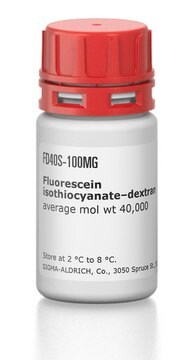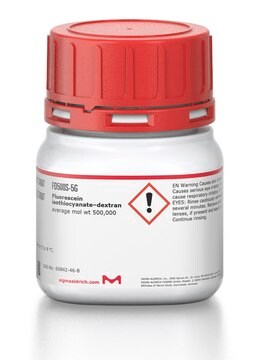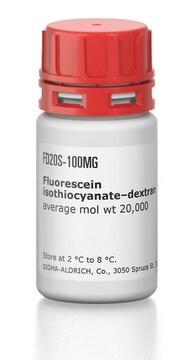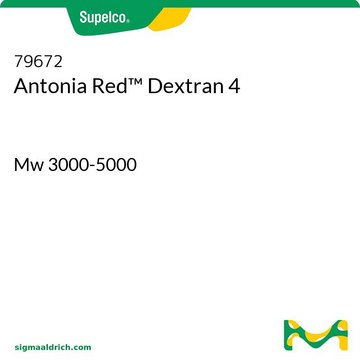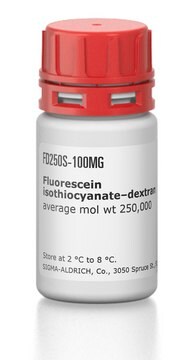Kluczowe dokumenty
FD4
Fluorescein isothiocyanate–dextran
average mol wt 3,000-5,000
Synonim(y):
FITC–Dextran
About This Item
Polecane produkty
pochodzenie biologiczne
synthetic
Poziom jakości
białko sprzężone
FITC conjugate
Formularz
powder
masa cząsteczkowa
average mol wt 3,000-5,000
zakres etykietowania
0.001-0.020 mol FITC per mol glucose
metody
HPLC: suitable
kolor
light yellow to dark orange
rozpuszczalność
H2O: 25 mg/mL
przydatność
suitable for HPLC
suitable for fluorescence indicator
suitable for fluorescent labeling techniques
Zastosowanie
life science and biopharma
metabolomics
microbiology
pharmaceutical
temp. przechowywania
2-8°C
Szukasz podobnych produktów? Odwiedź Przewodnik dotyczący porównywania produktów
Opis ogólny
In biochemical investigations focused on the blood-brain barrier (BBB), FITC-Dextran, particularly the variant with an average molecular weight of 4000, holds a central role. It serves as a dependable tool for evaluating the permeability of solutes, ions, and proteins across the BBB, facilitating an improved understanding of the barrier′s integrity and any potential disruptions. This contribution to biochemical exploration is invaluable in shedding light on the brain′s defense mechanisms.
Additionally, FITC-Dextran plays a pivotal role in studies related to cell permeability within the area of biochemical research. This extends to the assessment of BBB permeability and the extent of disruptions within the BBB, aspects that are fundamental to neuroscience and drug delivery research. These biochemical research facets are essential for comprehending disease mechanisms and formulating effective therapeutic strategies.
Furthermore, FITC-Dextran is a cornerstone in cardiovascular, microcirculation, and perfusion studies. It operates as a fluorescent flux tracer compound, allowing for the measurement of critical processes like blood flow, membrane integrity, vascular drainage, and renal elimination. In conclusion, FITC-Dextran proves to be an indispensable asset in the fields of biology, biochemistry, and medicine, offering unparalleled insights into the intricacies of cellular and tissue permeability, the integrity of the blood-brain barrier, and the understanding of diverse physiological and pathological processes.
Zastosowanie
- as a tracer molecule in membrane permeability study
Działania biochem./fizjol.
Cechy i korzyści
- Suitable for Biochemical and Biomedical research
- Versatile and adaptable for wide variety of laboratory and research applications
Uwaga dotycząca przygotowania
Inne uwagi
produkt podobny
Hasło ostrzegawcze
Warning
Zwroty wskazujące rodzaj zagrożenia
Zwroty wskazujące środki ostrożności
Klasyfikacja zagrożeń
Eye Irrit. 2 - Skin Irrit. 2 - STOT SE 3
Organy docelowe
Respiratory system
Kod klasy składowania
11 - Combustible Solids
Klasa zagrożenia wodnego (WGK)
WGK 3
Temperatura zapłonu (°F)
Not applicable
Temperatura zapłonu (°C)
Not applicable
Środki ochrony indywidualnej
Eyeshields, Gloves, type N95 (US)
Wybierz jedną z najnowszych wersji:
Masz już ten produkt?
Dokumenty związane z niedawno zakupionymi produktami zostały zamieszczone w Bibliotece dokumentów.
Klienci oglądali również te produkty
Produkty
Additional information about FITC-labelled polysaccarides including FITC-Dextran, FITC-DEAE-dextran (FDD), FITC-carboxymethyl-dextran (FCM-Dextran). This page discusses the impact of weight-average molecular weight on the respective molecule dimensions and other physical properties
Powiązane treści
Dekstran jest polimerem anhydroglukozy. Składa się w około 95% z wiązań alfa-D-(166). Pozostałe (163) wiązania odpowiadają za rozgałęzienie dekstranu.
Nasz zespół naukowców ma doświadczenie we wszystkich obszarach badań, w tym w naukach przyrodniczych, materiałoznawstwie, syntezie chemicznej, chromatografii, analityce i wielu innych dziedzinach.
Skontaktuj się z zespołem ds. pomocy technicznej
